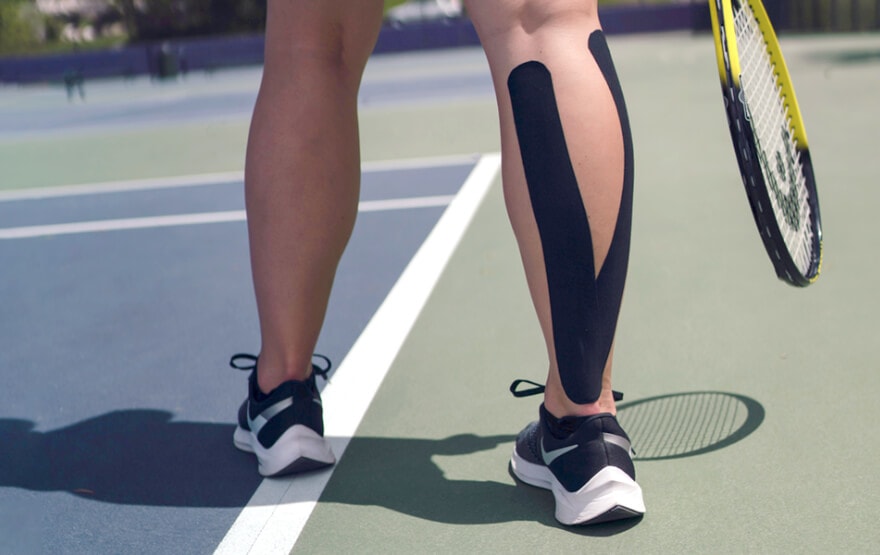Kinesiology tape has grown in popularity in both active individuals and athletes alike. So what’s all the hype about? In this article we will answer the question, “how does kinesiology tape work?” We’ll start by breaking down the science behind it, explaining the benefits, and deciphering when it is recommended.
So, What is Kinesiology Tape?
Kinesiology tape is defined as an elastic cotton strip with an acrylic adhesive designed for sticking directly to the skin. It comes in a variety of colors that correspond to different levels of both adhesion and stretch; providing anywhere from 10% to 90% stretch
Some brands offer precut strips for specific body parts while most offer different roll sizes that can be customized for individual use.
How Does Kinesiology Tape Work?
The premise from which kinesiology tape works is simple. The natural stretch found in the tape provides a gentle lift to the skin. This can have beneficial circulatory effects and provide additional sensory feedback to the problem area.
Even if kinesiology tape is simply applied directly to the skin without any stretch, the tape’s innate elasticity will provide approximately a 10% stretch to the skin. Additional stretch can be added to the tape simply by pulling on the tape as you lie it down on the skin. Most tape brands have built in wave-like lines that can help you ballpark the amount of stretch you are applying to the tape. How much stretch you will apply to the tape will depend on the area of the body you are addressing and what your overall goals are with the tape.
The Benefits of Kinesiology Tape
The jury is still out on what the true benefits are of kinesiology tape. This is because some of the claimed benefits are better researched and supported than others (some benefits often being attributed to the placebo effect). However, with all of the great stories, reviews, and research that can be found out there, it’s hard to deny that kinesiology tape can be a great option for helping address a wide variety of musculoskeletal issues. Here are the top potential benefits of using kinesiology tape.
- Improve blood flow and lymph flow for better healing and swelling management
- Boost the body’s proprioception for better coordination and mechanics following an injury
- Pain relief secondary to circulatory effects and mild support
- Better tolerance for full joint range of motion
- Enhance muscle strength; improve efficiency and activation of weak muscles (muscle re-education)
- Reduce use of overactive strained muscles (muscle re-education)
- Injury prevention; prevent overextension of a joint, over-contraction of a muscle, and/or cramping
- Improved injury management- reduced risk of re-injury, particularly following sports injuries
- Support injured tissue with minimal restriction
- Enhance sports performance
- Promote better posture with daily activities
- Scar tissue management
- A low cost way to assess the need for a long-term brace
Where Can I Apply Kinesiology Tape?
When it comes to kinesiology tape application, it can go practically anywhere. It is most commonly seen across large muscle groups along the neck, spine, shoulders and hips. However, any injured or affected joint or muscle group could benefit from the application of kinesiology tape.
Since kinesiology tape is so versatile, when you’re deciding whether or not to give it a try, we recommend reviewing these potential contraindications for application.
- Across any joint in the body including but not limited to the spine, hips, knees, ankles, fingers, toes, shoulder, etc.-
- Sensitive skin or fragile skin; particularly to adhesives or dye (keep in mind that kinesiology tape is most often latex free), common with allergies, and/or aging
- Placement on a skin rash or open wound
- Across particularly hairy areas- such as the scalp and limbs; this might warrant shaving an area if you wish to use tape
- Excessive swelling; particularly if caused by a heart condition, as this can overload the heart
- Suspected or confirmed deep vein thrombosis (a blood clot in the leg)
- Active cancer that you wouldn't want to increase circulation to
- Pregnancy; this is a precaution rather than a contraindication and will depend on each woman
- Diabetes; especially if peripheral neuropathy is compromising local sensation
Taping by Injury:
When Can I Use Kinesiology Tape
Indications for kinesiology tape can include one or more of following:
- Looking for support, circulation, and pain relief
- Support common orthopedic issues like knee pain, poor knee cap tracking, and back pain
- To encourage better mechanics, sensation, and biofeedback with movement
- Injured muscles, muscle pain, weakness, or overuse
- Swollen limbs from an injury or poor lymphatic drainage; designed to “pull” fluid from the limb toward the heart
- Across the pelvis and limbs for prenatal discomfort
- Muscle knots (trigger points) to reduce tension and promote pain relief
Tips for Applying Kinesiology Tape
There are some basic rules to keep in mind when applying kinesiology tape. These tips ensure the best possible comfort, efficacy, and longevity of your tape.
- Purchase a role of kinesiology tape instead of precut strips for more versatility
- Determine how much tape you need by measuring the area you hope to cover and cutting your strips accordingly
- Wash the skin the alcohol to rid the area of natural oils and lotions that could compromise the adhesive
- Before applying the tape, always round the edges of the tape with your scissors to prevent unnecessary catching on clothing and prolong the efficacy of the tape
- When placing the tape on your skin, never put stretch on the edges to reduce skin irritation and prolong tape life
- As long as no skin irritation or change in symptoms is evident, you can keep the tape on for for up to 48 hours (sometimes even longer)
- You can shower with kinesiology tape on; simply pat it dry with a towel
- To reduce skin irritation, do not exceed 50% stretch with your tape during application
- If you notice any skin irritation, itching, redness, or swelling, remove the tape immediately
- When removing kinesiology tape, do so gently to avoid skin damage (do not rip it away like a bandaid)
- If you aren’t sure where to start with your taping techniques, it’s always best to consult a professional; such as an orthopedic doctor, chiropractor, or physical therapist
Bracing vs. Taping
Kinesiology tape and a brace have relatively different functions. Both options can be used to offer support to a local joint that is sprained, unstable, painful, and/or hypermobile. Deciding what to use will depend on your long term goals
- Bracing offers a much more rigid support structure.
- If you find kinesiology tape isn’t offering enough support, consider moving to a brace for more rigid support.
- For long-term issues, bracing may be more cost effective
- Kinesiology tape is less intrusive
You may also consider the use of different types of tape that are more rigid, such as athletic tape or leuko tape. You can discuss which option is best for you with your doctor or therapist.
Give Taping a Try
The opportunities for pain relief, injury recovery, and overall health management with kinesio taping are endless. In the end, kinesiology tape is a very cost effective tool that can be utilized to expedite your recovery goals with little to no risk to you. The real question to ask here is, why not give it a try? Depending on your problem area and local deficits, you can try several different techniques and see which option provides you the best outcomes. As always, if your symptoms suddenly change or get worse, always consult a professional for immediate medical advice.
Sources:
https://www.verywellhealth.com/kinesiology-tape-in-physical-therapy-2696435
https://ethoshealth.com.au/ankle-taping-vs-bracing-which-is-better/


![The Benefits of Flexibility [A.K.A. The Secret Sauce for Aging]](http://www.vivehealth.com/cdn/shop/articles/Smiling-retired-woman-listening-to-music-while-stretching-legs-outdoors._600x.jpg?v=1713090677)

